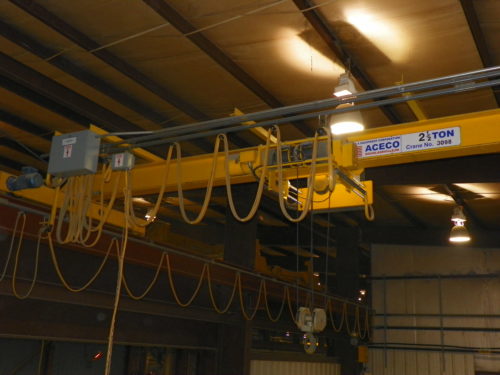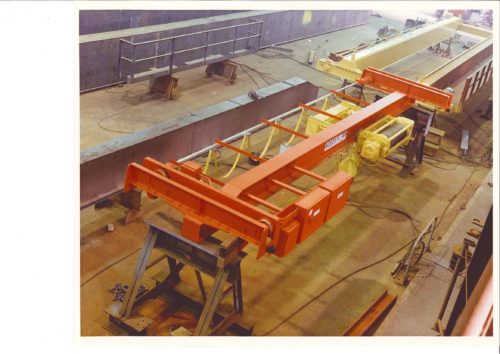When it comes to overhead cranes, there are several options to choose from, including top-running and under-running. While top-running and under-running overhead cranes are both used to lift and move loads vertically and horizontally, each type offers their own unique advantages. Understanding the differences between these two types of cranes will help you determine which one is best for your needs.
Top-Running Overhead Cranes
 Top-running overhead cranes run on a fixed rail mounted on top of each runway beam, which allows the end trucks to carry the girder and hoist along the top. These cranes can be set up as a single girder or double girder depending on the application needs. A single girder has a trolley and hoist mounted on the bottom, whereas a double girder uses a top running trolley and hoist, allowing for additional lift height and a higher hook height.
Top-running overhead cranes run on a fixed rail mounted on top of each runway beam, which allows the end trucks to carry the girder and hoist along the top. These cranes can be set up as a single girder or double girder depending on the application needs. A single girder has a trolley and hoist mounted on the bottom, whereas a double girder uses a top running trolley and hoist, allowing for additional lift height and a higher hook height.
Some key advantages of top-running overhead cranes include:
- No limiting capacity. This allows for the ability to handle both small and large loads.
- Added lift height. Being mounted on top of each runway beam allows for increased lift height, which is beneficial to buildings with limited headroom.
- Built for higher capacities. Top-running overhead cranes are built larger than under-running cranes to grant them the ability to handle higher capacities.
- Easy installation. Since the crane is supported by the runway beams, it eliminates the suspended load factor to make installation simple.
- Less maintenance. Over time, top-running overhead cranes do not require as much maintenance other than the routine checking of the tracking for proper alignment and any issues.
Under-Running Overhead Cranes
 Designed with flexibility and functionality in mind, under-running overhead cranes have a user-friendly design that provides ultimate versatility for meeting all your production needs. These cranes are also known as underhung cranes because the bottom flange of the runway beam offers support for the wheels to move the bridge across the facility.
Designed with flexibility and functionality in mind, under-running overhead cranes have a user-friendly design that provides ultimate versatility for meeting all your production needs. These cranes are also known as underhung cranes because the bottom flange of the runway beam offers support for the wheels to move the bridge across the facility.
The trolley and hoist of an under-running overhead crane move across the bottom flange of the bridge beam, lowering the crane’s hook and lift height. Under-running overhead cranes are usually set up as single girder because a double girder design is often more expensive and not suitable for the application.
Some advantages of under-running overhead cranes include:
- Operates well in wide bays. Underhung cranes can be operated in multiple runways, reducing the depth of the girder.
- Lighter overall design requirements. Under-running overhead cranes are much lighter, which removes the need for additional supporting columns that take up precious floor space. Instead, the crane utilizes the existing overhead building structure for support.
- Lower costs. The lightweight design and use of the existing ceiling trusses or roof structure result in lower equipment costs.
- Ability for multiple crane installations. It is possible to install under-running cranes next to each other and operate them at the same time for increased production efficiency.
Overhead Cranes at American Crane
It is important to understand the advantages of top-running and under-running overhead cranes to help you select the best option for your production needs. At American Crane, we are a leading manufacturer of cranes, hoists, and other material handling equipment. As a member of the Crane Manufacturers Association of America (CMAA), our team of experts can provide you with an overhead crane solution suited to your project’s specifications. For more information on our capabilities, contact us or request a quote today.

